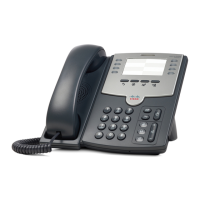Configuring Security, Quality, and Network Features
Ensuring Voice Quality
Cisco Small Business SPA300 Series, SPA500 Series, and WIP310 IP Phone Administration Guide 135
5
G.729a, G.722 (not supported on WIP310) and G.723.1. (not supported on
the SPA525G or WIP310.)
• The encoder and decoder pair in a compression algorithm is known as a
codec. The compression ratio of a codec is expressed in terms of the bit
rate of the compressed speech. The lower the bit rate, the smaller the
bandwidth required to transmit the audio packets. Although voice quality is
usually lower with a lower bit rate, it is usually higher as the complexity of
the codec gets higher at the same bit rate.
• Silence suppression—Cisco IP phones apply silence suppression so that
silence packets are not sent to the other end to conserve more transmission
bandwidth. IP bandwidth is used only when someone is speaking. Voice
activity detection (VAD) with silence suppression is a means of increasing
the number of calls supported by the network by reducing the required
bidirectional bandwidth for a single call. A noise level measurement is sent
periodically during silence suppressed intervals so that the other end can
generate artificial comfort noise (comfort noise generator, or CNG).
• Packet loss—Audio packets are transported by UDP, which does not
guarantee the delivery of the packets. Packets may be lost or contain errors
that can lead to audio sample drop-outs and distortions and lower the
perceived voice quality. The Cisco SPA IP Phones apply an error
concealment algorithm to alleviate the effect of packet loss.
• Network jitter—The IP network can induce varying delay of received
packets. The RTP receiver in Cisco IP phones keeps a reserve of samples
to absorb the network jitter, instead of playing out all the samples as soon
as they arrive. This reserve is known as a jitter buffer. The bigger the jitter
buffer, the more jitter it can absorb, but this also introduces bigger delay.
Jitter buffer size should be kept to a relatively small size whenever
possible. If jitter buffer size is too small, many late packets may be
considered as lost and thus lowers the voice quality. Cisco IP phones
dynamically adjust the size of the jitter buffer according to the network
conditions that exist during a call.
The minimum jitter buffer size is 30 milliseconds or (10 milliseconds +
current RTP frame size), whichever is larger, for all jitter level settings.
However, the starting jitter buffer size value is larger for higher jitter
levels. This setting controls the rate at which the jitter buffer size is
adjusted to reach the minimum. Select the appropriate setting: low,
medium, high, very high, or extremely high. Defaults to high.

